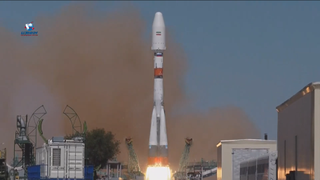
Iran will soon have access to sharp orbital imagery, thanks to a newly launched spy satellite.
That spacecraft, called Khayyam, lifted off atop a Russian Soyuz rocket today (Aug. 9) at 1:52 a.m. EDT (0552 GMT) from the Russia-run Baikonur Cosmodrome in Kazakhstan.
Russian state media provider TASS confirmed the satellite is sending telemetry successfully, according to Russian-language translation provided by Google.
Khayyam, which is named after the famed Persian poet and mathematician Omar Khayyam, is a Russian-built Kanopus-V Earth-observation satellite that can resolve features as small as 3.9 feet (1.2 meters) on Earth's surface, The Washington Post reported last week.
Related: Iran in space: rockets, satellites & monkeys (photos)
"That’s far short of the quality achieved by U.S. spy satellites or high-end commercial satellite imagery providers, but a substantial improvement over Iran's current capabilities," The Washington Post wrote.
"Potentially the most significant benefit," the newspaper added, citing unnamed Western security officials, "will be Iran’s ability to 'task' the new satellite to conduct continuous surveillance on locations of its choosing, including military facilities in Israel, oil refineries and other vital infrastructure in neighboring gulf states."
Get the Space.com Newsletter
Breaking space news, the latest updates on rocket launches, skywatching events and more!
Before Khayyam's launch, Iran had just two operational satellites in space, according to the United States Institute of Peace: Sina 1, which launched on an apparent imaging and communications mission in 2005, and Noor 2, an imaging satellite that lifted off this past March.
Russia negotiated the Khayyam satellite deal in secret with Iran's Islamic Revolutionary Guard Corps over the course of multiple years, The Washington Post reported in June of last year. In that story, The Post noted that Russian experts had already traveled to Iran to train ground crews in the satellite's operation.
But Iran apparently won't get access to its fancy new space hardware right away. Russia intends to use Khayyam "for several months, or longer, to enhance its surveillance of military targets" for its ongoing invasion of Ukraine, The Washington Post reported in last week's story, citing the Western security officials, who wished to remain anonymous.
Iranian officials, however, are denying the claims that they won't have access to the hardware right away. "Tehran has rejected claims the satellite could be used by Moscow to boost its intelligence capabilities in Ukraine, saying Iran will have full control and operation over it 'from day one'," a Reuters report stated, quoting the Iranian state-run official IRNA news agency.
Khayyam didn't launch alone on Tuesday morning. Also riding the Soyuz off Earth were 16 smaller satellites, which were built by a variety of Russian universities, companies and nonprofit organizations, according to the state-run Russian news agency TASS, which cited an Aug. 3 press conference briefing by Roscosmos, Russia's federal space agency.
Mike Wall is the author of "Out There" (Grand Central Publishing, 2018; illustrated by Karl Tate), a book about the search for alien life. Follow him on Twitter @michaeldwall. Follow us on Twitter @Spacedotcom or on Facebook.
Join our Space Forums to keep talking space on the latest missions, night sky and more! And if you have a news tip, correction or comment, let us know at: community@space.com.

Michael Wall is a Senior Space Writer with Space.com and joined the team in 2010. He primarily covers exoplanets, spaceflight and military space, but has been known to dabble in the space art beat. His book about the search for alien life, "Out There," was published on Nov. 13, 2018. Before becoming a science writer, Michael worked as a herpetologist and wildlife biologist. He has a Ph.D. in evolutionary biology from the University of Sydney, Australia, a bachelor's degree from the University of Arizona, and a graduate certificate in science writing from the University of California, Santa Cruz. To find out what his latest project is, you can follow Michael on Twitter.
